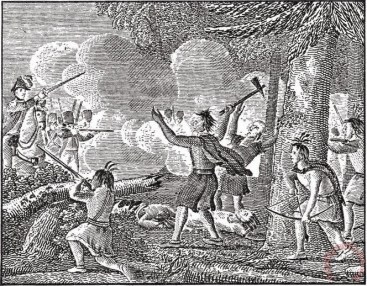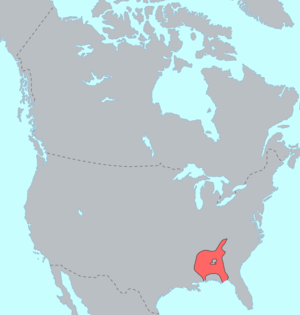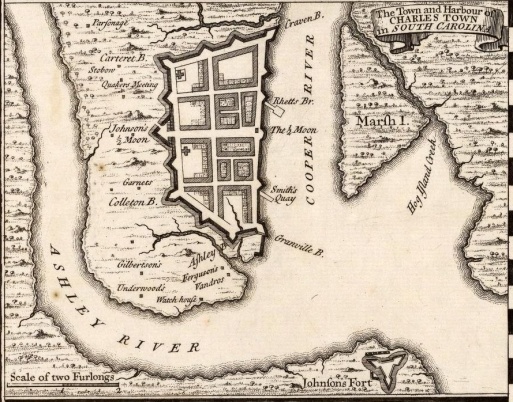Lately I have been reading Vae Victus, the sequel to Albert Sanchez Piñol’s military epic/picaresque novel Victus. The first part of the book is called Americanus. In it, the protagonist, a military engineer who escaped the fall of Barcelona in 1714, finds himself in the middle of a war between the Yamasee and the South Carolina colonists. For a while, the Yamasee army threatened the existence of South Carolina in the aptly named Yamasee War, and they even conquered the city of Port Royal. However, they were ultimately defeated and ended up vanishing. Today, not much is know of their culture. In this post I put together what we know of the language they spoke.

Muskogean languages
The Yamasee have traditionally been grouped with the Muskogean language family, most likely because their allies in the Yamasee War were Muskogean-speaking groups, like the Chickasaw or the Guale. It is not clear if the Yamasee were a linguistic group that existed prior to the military ethnic alliance: it could have been originated by the union of independent groups, mostly speakers of Muskogean languages (Oatis 2004).

The Muskogean language family
The medium-sized Muskogean family is spoken in the South East of the USA. Today, it comprises six living languages: Alabama, Chickasaw, Choctaw, Creek-Muskogee, Koasati and Mikasuki. These languages have an avegage-sized inventory of consonants. Vowel inventories are much smaller, although a phonological length contrast is a trait of the family, as is nasality. Muskogean languages are mostly agglutinative, that is, a single word or morpheme can include different meanings or notions. Verbs have what muskogeanists call “grades”, a very complex form-alternation system based on aspect, tense or mood.
Muskogean languages are unfortunately seriously endangered with extinction, although their speaker communities appear to be struggling to keep their languages alive. We can get a glimpse at a Muskogean language like Chickasaw here, and even learn to say some words and sentences: http://www.chickasaw.tv
The Yamasee language
Broadwell (1991) has argued that Yamasee and Guale should both be considered extinct Muskogean languages. His hypothesis is based on a collection of words done by the German protestant pastor Johann Martin Bolzius, and another one collected by Baron Philipp Georg Friedrich von Reck, the commissioner of Salzburger immigrants to the settlement of Savannah, near the old Yamasee territory. Both journals were written in the 1730s in German, and both men used Greek alphabet to transcribe the words, since “the Indian language . . . can best be written with Greek Letters, because of the long and short Vowels; and some of their Sounds, cannot be expressed by any other alphabet but the Greek.”
In a reply to Broadwell, Sturtevant (1994) argues that the printed sources of the wordlists contain some printing and copying errors. After addressing and correcting those, Sturtevant concludes that the language in question is not Yamasee or Guale, but simply Creek. This is consistent with the labelling of some natural history drawings by von Reck in German with two languages identified as Creek and “Uchi” (Yuchi), accompanied with mentions of two Indian languages spoken in the area close to the old Yamasee territory. By that time the Yamasee had already fled South Carolina to relocate in Spanish Florida, where they slowly died out, and the question remains whether a significant number of them stayed behind. Sturtevant considers that we have no evidence to support this.
There are mentions of a group of indians near Savannah called Yamacraw, but they are also described as speaking the same language as the Lower Creeks, although they were also said to be in part composed of Yamasee indians. For Sturtevant the claim that the Yamacraw were related to the Yamasee is sustained by little evidence beyond the similarity of the two names, and the fact that the Yamacraw were located in the area where the Yamasee War took place. His conclusion is that Yamasee should still be considered a nomina nuda language, a language for which we do not in fact have any linguistic evidence.

Barring the discovery of some lost evidence that points directly to the Yamasee language, our best guesswork will have to do the trick. Even if the relationship with Muskogean languages seems a reasonable hypothesis, it is by no means the only possibility. We don’t know what their language actually looked like, and it could have been anything from a typical Muskogean language to a vanished branch of a Macro-Muskogean family, or even an Iroquoian language.
-Refs.
Broadwell, George A. 1991. The Muskogean connection of the Guale and Yamasee. IJAL 57, no. 2:267-70.
Oatis, Steven J. 2004. A Colonial Complex: South Carolina’s Frontiers In The Era Of The Yamasee War, 1680-1730. University of Nebraska Press.
Sturtevant, William C. 1994. The Misconnection of Guale and Yamasee with Muskogean. IJAL 60, no. 2:139-148.